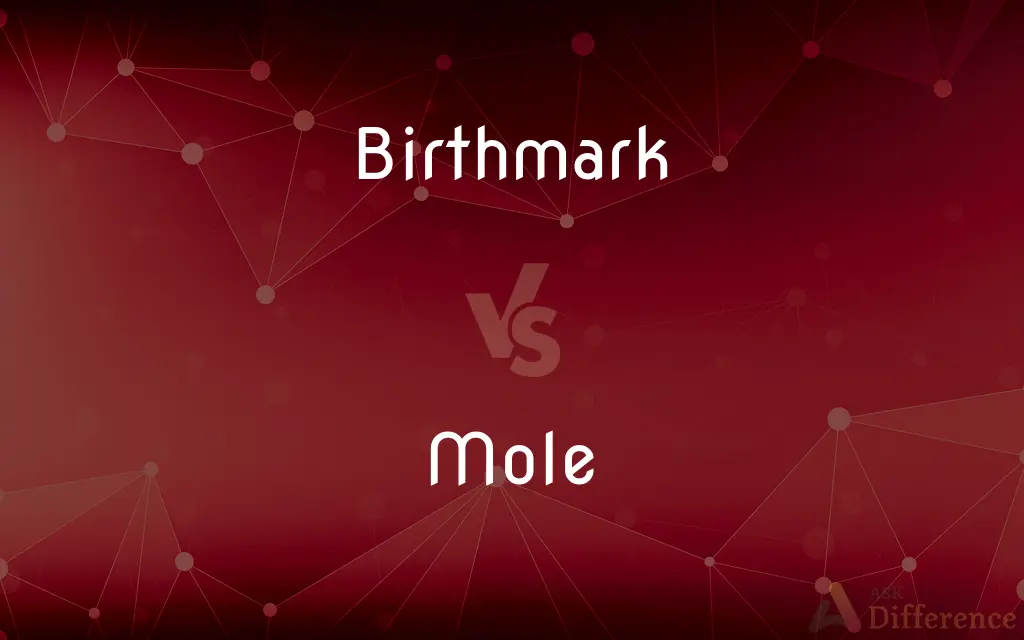Birthmark vs. Mole — What's the Difference?
By Maham Liaqat & Fiza Rafique — Updated on April 2, 2024
Birthmarks are congenital skin marks, varying widely in appearance, while moles are small, dark skin growths that can develop over time.

Difference Between Birthmark and Mole
Table of Contents
ADVERTISEMENT
Key Differences
Birthmarks are unique marks on the skin that are present at birth or shortly thereafter, showcasing a range of colors, sizes, and shapes. Moles, on the other hand, are small, often pigmented skin growths that can appear anywhere on the body, typically emerging in childhood and adolescence.
While birthmarks are generally benign and vary significantly in appearance—from flat or raised to different colors like pink, red, or brown—moles are usually brown or black and can become more pronounced with sun exposure or during pregnancy. Moles may also evolve over time in color, shape, or hairiness.
Birthmarks, such as vascular birthmarks (including port-wine stains and hemangiomas) and pigmented birthmarks, are caused by overgrowths of blood vessels or melanocytes, respectively. Whereas moles are formed by clusters of melanocytes, the cells giving skin its pigment, indicating a more uniform cause compared to the diverse origins of birthmarks.
The significance of birthmarks is primarily cosmetic, except in rare cases where they may signal underlying health issues. Moles, while also often benign, require monitoring for changes that could indicate melanoma, a serious form of skin cancer.
Most birthmarks do not require treatment unless they pose health risks or cosmetic concerns, for which laser therapy or surgery can be options. Moles may be removed for biopsy or if they present a cancer risk or cosmetic issue, typically through surgical excision or shaving.
ADVERTISEMENT
Comparison Chart
Definition
Congenital skin marks, varied in appearance
Small, dark skin growths, often pigmented
Appearance
Wide range; can be flat, raised, different colors
Typically brown or black, can be raised or flat
Cause
Overgrowths of blood vessels or melanocytes
Clusters of melanocytes
Significance
Mostly cosmetic, rarely health-related
Cosmetic; potential indicator of skin cancer
Treatment
Rarely needed; cosmetic procedures if necessary
Monitoring; removal for biopsy or cosmetic reasons
Compare with Definitions
Birthmark
A birthmark resulting from blood vessels that have not formed correctly.
His port-wine stain, a type of vascular birthmark, covered his right cheek.
Mole
A small, dark skin growth formed by a cluster of melanocytes, often appearing during childhood.
He had a mole above his lip that darkened as he grew older.
Birthmark
A congenital, often irregular mark on the skin, present at birth or appearing shortly after.
The baby had a small, heart-shaped birthmark on her left shoulder.
Mole
A dangerous form of skin cancer that can develop from moles.
Regular checks are important as changes in a mole's appearance can indicate melanoma.
Birthmark
Birthmarks caused by an overgrowth of pigment cells.
The pigmented birthmark on her back was darker than the surrounding skin.
Mole
A mole that looks different from a common mole and has a higher risk of becoming melanoma.
The dermatologist decided to remove the dysplastic nevus as a precautionary measure.
Birthmark
A bright red or purple birthmark that appears as a rubbery bump and is made up of extra blood vessels.
The pediatrician explained that the hemangioma might grow with the baby but often fades with time.
Mole
Cells in the skin that produce melanin, responsible for skin color and moles.
Moles are clusters of melanocytes that have grown together in a tight group.
Birthmark
A flat, red or purple birthmark made up of dilated blood capillaries.
The port-wine stain birthmark was visible on the side of her face.
Mole
The process of surgically removing a mole, either for biopsy or cosmetic reasons.
She underwent mole removal surgery for the large mole on her back.
Birthmark
A birthmark is a congenital, benign irregularity on the skin which is present at birth or appears shortly after birth—usually in the first month. They can occur anywhere on the skin.
Mole
A small burrowing mammal with dark velvety fur, a long muzzle, and very small eyes, feeding mainly on worms, grubs, and other invertebrates.
Birthmark
A skin lesion, such as a nevus or angioma, that is present at birth.
Mole
A spy who gradually achieves an important position within the security defences of a country
A well-placed mole was feeding them the names of operatives
Birthmark
A mark on the skin formed before birth.
Mole
A small, often slightly raised blemish on the skin made dark by a high concentration of melanin
A mole on her arm had not been there at the beginning of the summer
Birthmark
Some peculiar mark or blemish on the body at birth.
Most part of this noble lineage carried upon their body for a natural birthmark, . . . a snake.
Mole
A large solid structure on a shore serving as a pier, breakwater, or causeway.
Birthmark
A blemish on the skin formed before birth
Mole
The SI unit of amount of substance, equal to the quantity containing as many elementary units as there are atoms in 0.012 kg of carbon-12.
Mole
An abnormal mass of tissue in the uterus.
Mole
A highly spiced Mexican sauce made chiefly from chilli peppers and chocolate, served with meat.
Mole
A skin lesion, commonly a nevus, that is typically raised and discolored.
Mole
Any of various small insectivorous mammals of the family Talpidae of North America and Eurasia, usually living underground and having a thickset body with light brown to dark gray silky fur, strong forefeet for burrowing, and often rudimentary eyes.
Mole
A machine that bores through hard surfaces, used especially for tunneling through rock.
Mole
A spy who operates from within an organization, especially a double agent operating against that agent's own government from within its intelligence establishment.
Mole
A massive, usually stone wall constructed in the sea, used as a breakwater and built to enclose or protect an anchorage or a harbor.
Mole
The anchorage or harbor enclosed by a mole.
Mole
A fleshy abnormal mass formed in the uterus by the degeneration or abortive development of an ovum.
Mole
In the International System, the base unit used in representing an amount of a substance, equal to the amount of that substance that contains as many atoms, molecules, ions, or other elementary units as the number of atoms in 0.012 kilogram of carbon-12. The number is 6.0221 × 1023, or Avogadro's number. See Table at measurement.
Mole
A pigmented spot on the skin, a naevus, slightly raised, and sometimes hairy.
Mole
Any of several small, burrowing insectivores of the family Talpidae; also any of southern African mammals in the family Chrysochloridae (golden moles) and any of several Australian mammals in the family Notoryctidae (marsupial moles), similar to but not closely related to Talpidae moles
Mole
Any of the burrowing rodents also called mole-rats.
Mole
(espionage) An internal spy, a person who involves himself or herself with an enemy organisation, especially an intelligence or governmental organisation, to determine and betray its secrets from within.
Mole
A kind of self-propelled excavator used to form underground drains, or to clear underground pipelines
Mole
A type of underground drain used in farm fields, in which a mole plow creates an unlined channel through clay subsoil.
Mole
A moll, a bitch, a slut.
Mole
(nautical) A massive structure, usually of stone, used as a pier, breakwater or junction between places separated by water.
Mole
(rare) A haven or harbour, protected with such a breakwater.
Mole
(historical) An Ancient Roman mausoleum.
Mole
In the International System of Units, the base unit of amount of substance; the amount of substance of a system which contains exactly 6.02214076×1023 elementary entities (atoms, ions, molecules, etc.). Symbol: mol. The number of atoms is known as Avogadro’s number. from 1897
Mole
A hemorrhagic mass of tissue in the uterus caused by a dead ovum.
Mole
One of several spicy sauces typical of the cuisine of Mexico and neighboring Central America, especially a sauce which contains chocolate and which is used in cooking main dishes, not desserts.
Mole
A spot; a stain; a mark which discolors or disfigures.
Mole
A spot, mark, or small permanent protuberance on the human body; esp., a spot which is dark-colored, from which commonly issue one or more hairs.
Mole
A mass of fleshy or other more or less solid matter generated in the uterus.
Mole
A mound or massive work formed of masonry or large stones, etc., laid in the sea, often extended either in a right line or an arc of a circle before a port which it serves to defend from the violence of the waves, thus protecting ships in a harbor; also, sometimes, the harbor itself.
Mole
Any insectivore of the family Talpidæ. They have minute eyes and ears, soft fur, and very large and strong fore feet.
Mole
A plow of peculiar construction, for forming underground drains.
Mole
A spy who lives for years an apparently normal life (to establish a cover) before beginning his spying activities.
Mole
A quantity of a substance equal to the molecular weight of a substance expressed in grams; a gram molecule; the basic unit of amount of substance adopted under the System International d'Unites; as, he added two moles of sodium chloride to the medium.
Mole
To form holes in, as a mole; to burrow; to excavate; as, to mole the earth.
Mole
To clear of molehills.
Mole
The molecular weight of a substance expressed in grams; the basic unit of amount of substance adopted under the Systeme International d'Unites
Mole
A spy who works against enemy espionage
Mole
Spicy sauce often containing chocolate
Mole
A small congenital pigmented spot on the skin
Mole
A protective structure of stone or concrete; extends from shore into the water to prevent a beach from washing away
Mole
Small velvety-furred burrowing mammal having small eyes and fossorial forefeet
Common Curiosities
Do all birthmarks need to be removed?
No, most birthmarks do not require removal unless they present health risks or significant cosmetic concerns.
Are birthmarks hereditary?
Some types of birthmarks can be hereditary, but the exact causes are often not fully understood.
Can a mole turn into cancer?
Yes, moles can potentially turn into melanoma, a serious form of skin cancer, which is why monitoring for changes is important.
What is the main difference between a birthmark and a mole?
Birthmarks are congenital marks that vary in appearance, while moles are small, pigmented skin growths that develop over time.
Is it common for babies to be born with moles?
While it's possible, it's more common for moles to develop during childhood and adolescence.
How can I tell if a mole is dangerous?
A mole that changes in size, shape, color, or texture, or that bleeds, itches, or becomes painful, should be evaluated by a dermatologist.
Are vascular birthmarks permanent?
Some vascular birthmarks, like hemangiomas, may fade over time, while others, like port-wine stains, are usually permanent without treatment.
Can both birthmarks and moles appear anywhere on the body?
Yes, both can appear anywhere on the body, but birthmarks are present from birth or shortly after, whereas moles generally develop later.
Can moles be removed for cosmetic reasons?
Yes, moles can be removed for cosmetic reasons through surgical procedures.
What is a dysplastic nevus?
A dysplastic nevus is a mole that looks different from a common mole and may have a higher risk of turning into melanoma.
What causes moles to form?
Moles form due to clusters of melanocytes, or pigment-producing cells, in the skin.
What treatments are available for birthmarks?
Treatments for birthmarks can include laser therapy, surgery, or in some cases, no treatment is necessary if the birthmark does not affect health.
Why do some people have more moles than others?
Genetic factors, sun exposure, and hormonal changes can affect the number of moles a person has.
What is the best way to monitor moles for changes?
Regular skin checks and photographs to track changes over time are effective ways to monitor moles.
Can birthmarks change over time?
Some types of birthmarks, particularly hemangiomas, can change in size and appearance over time.
Share Your Discovery

Previous Comparison
Frog vs. Crapaud
Next Comparison
Shrew vs. MouseAuthor Spotlight
Written by
Maham LiaqatCo-written by
Fiza RafiqueFiza Rafique is a skilled content writer at AskDifference.com, where she meticulously refines and enhances written pieces. Drawing from her vast editorial expertise, Fiza ensures clarity, accuracy, and precision in every article. Passionate about language, she continually seeks to elevate the quality of content for readers worldwide.















































